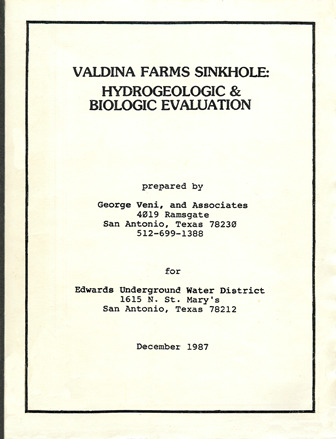Valdina Farms Sinkhole: Hydrogeologic & Biologic Evaluation

| Summary |
|
On 5 December, 1987, Valdina Farms Sinkhole was investigated to determine the impact of the first massive flooding since the construction of the Seco Creek Recharge Dam and Diversion Channel. The cave was observed for physical changes, including the exploration and survey of new passages, as well as observations of the cave’s ecosystem and hydrogeology. The only major physical changes in the cave were the entrenchment of the floor and the washing-out of large mud and guano deposits deeper into the aquifer. No evidence of siltation was encountered. A new small stream passage was opened by the flood, located off the main passage upstream of the entrance, but was not fully explored. Domes downstream were explored and surveyed in hopes of finding a bypass to nearby Sump 1, but only a large upper room was discovered. Sump 1 was dove, using SCUBA, and was found to be approximately 100m long. On the sump’s far side the air-filled passage was explored for 340 m to Sump 2. In total, the cave’s explored length was increased by more than 50%. Biologically, the cave’s diverse and extensive fauna was decimated. The terrestrial fauna had drown [sic] and catfish, washed in by the flood, had eaten the cave’s aquatic fauna. No bat colonies were observed, although two stray bats were present. Whether or not the cave is repopulated by species migrating from other caves will require further observation. Hydrologically, the cave transmitted a very significant volume of recharge into the Edwards Aquifer. It shows no indication that it cannot continue to do so, although further downstream exploration is required. Estimated peak recharge rates for the cave, prior to flooding, may have been beyond the cave’s capacity, however, discharge rates for the cave prior to its overflowing are not available. Nonetheless, the recharge event created a tremendous groundwater mound as water levels in area wells continued to rise for up to 4 months after the flood. The recommendations include that the survey and exploration of the cave should continue to better facilitate, and increase the comprehension, of studies that will and are being done. The primary area of exploration would be downstream, although the upstream areas are also of significance. The cave should also be visited once each winter, spring and late summer, up through 1989, to determine the full impact of flooding on the ecosystem and its recovery. Lastly, a series of dye tracing should be run to delineate the cave’s upstream drainage area and downstream flow paths, and the number of local groundwater monitoring wells should be increased, including the placement of two into the cave. |
Search for Documents
Advance Search
Explore EAA's Scientific Reports
- All Reports
- Precipitation
- Overview Studies
- Modeling
- Hydrology and Hydrogeology
- History
- Groundwater Recharge, Recharge Zone
- Groundwater Movement
- Geomorphology and Caves
- Weather Modification
- Geology
- Water Use and Conservation
- Geochemistry
- Water Resources Planning and Management
- Floods and Drought
- Water Quality
- Climatology
- Surface Water / Groundwater Relationship
- Biology
- Springs, Groundwater Discharge
- Archaeology
- RZ Protection
- Aquifer Levels
- Remote Sensing
